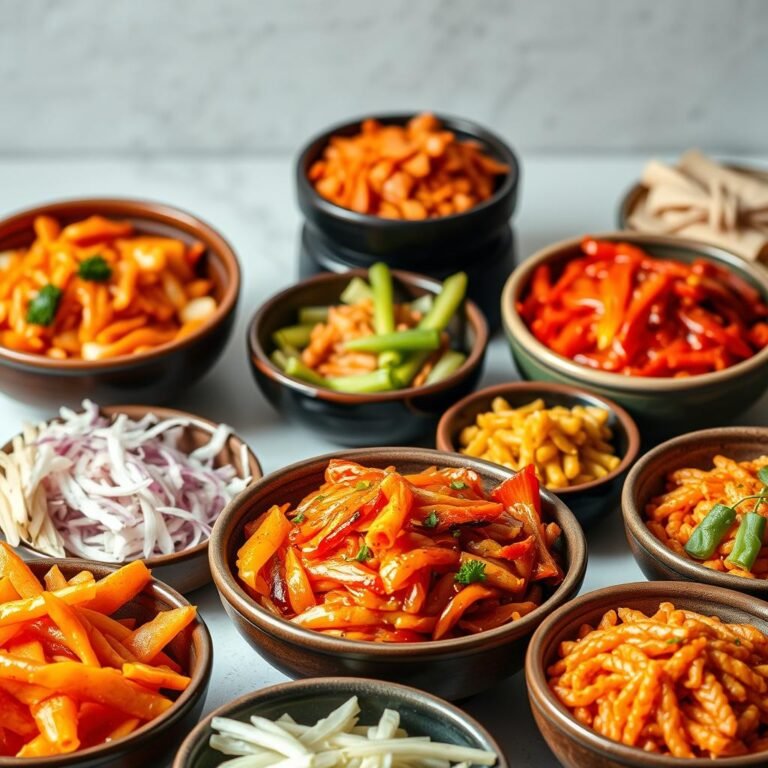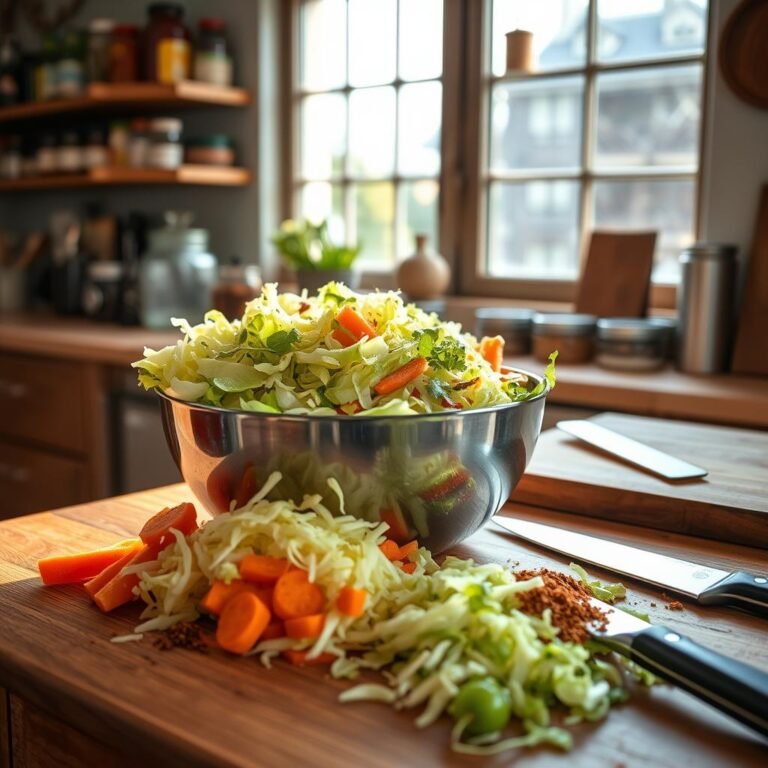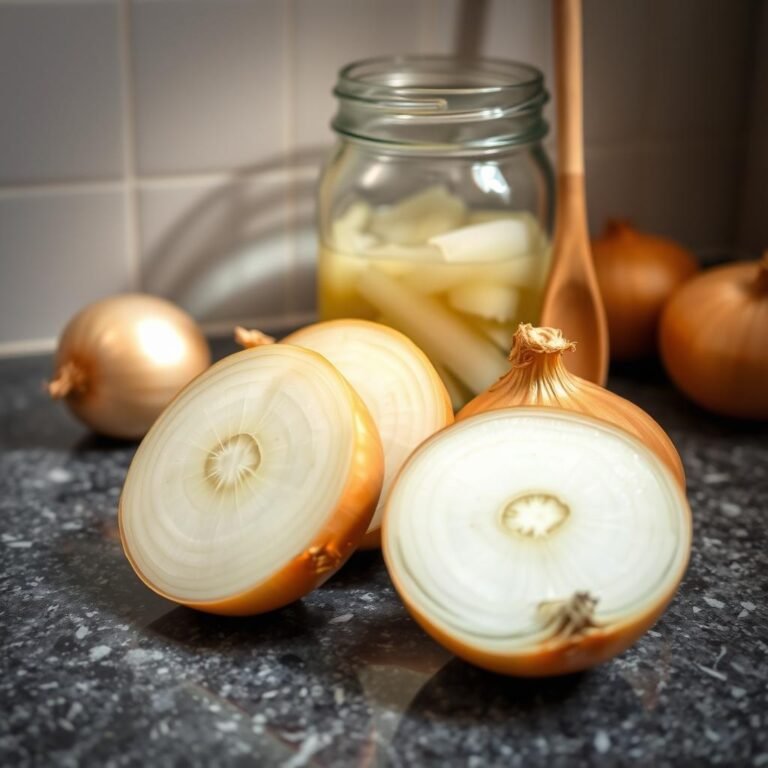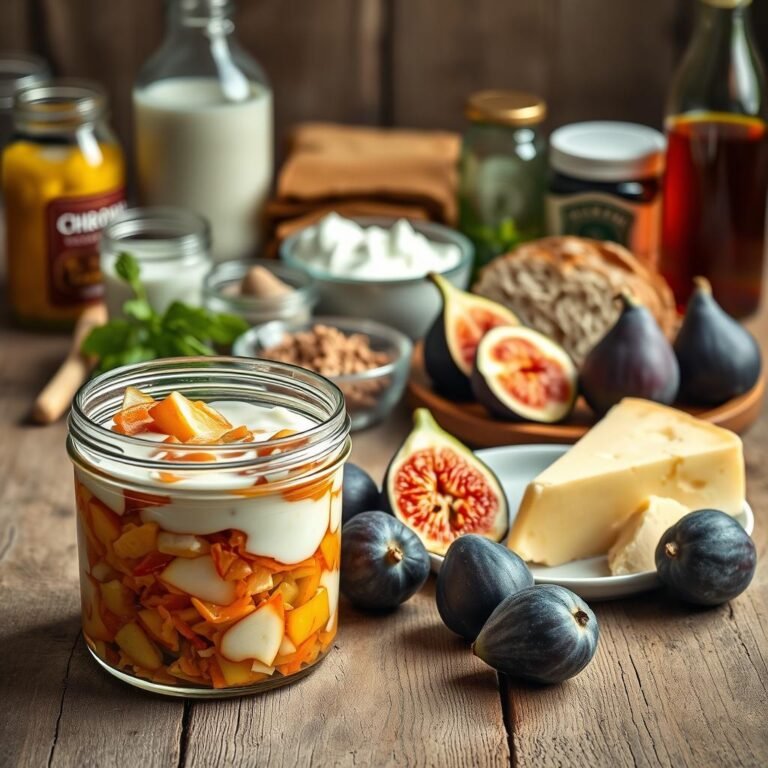Why Is Green Bean Kimchi Considered a Probiotic Food

Green bean kimchi is known for its high probiotic content. It’s a food that’s good for your gut health. This makes it a great choice for keeping your digestive system balanced.
Let’s explore why green bean kimchi is so special. We’ll also look at the health benefits it offers.
Introduction to Green Bean Kimchi
Green bean kimchi is a special fermented food in Korean cuisine. It’s known for its health perks and unique taste. This dish shows the skill of fermentation and old cooking ways.
What is Green Bean Kimchi?
Green bean kimchi, or kong-namul kimchi, is a special version of Korean food. It’s made with fresh green beans, spices, garlic, and ginger. Then, it’s left to ferment.
This process makes it taste better and adds good bacteria for our guts.
Historical Background
Green bean kimchi’s history goes back to ancient Korea. Back then, fermentation was key for keeping food fresh. People made it during harvest time and stored it in clay jars.
This kept the veggies fresh and gave people nutrients during cold winters. Today, it’s a beloved food in Korean homes, valued for its history and health benefits.
Fermentation Process in Green Bean Kimchi
The fermentation process in green bean kimchi is amazing. It makes the flavors richer and adds good nutrients. This change happens thanks to lacto-fermentation. It uses lactic acid bacteria to keep vegetables fresh and boost their health benefits.
Lacto-Fermentation Basics
Lacto-fermentation is a traditional way to ferment foods. It uses lactic acid bacteria to turn sugars into lactic acid. This method keeps the green beans fresh and adds a tangy taste, like kimchi.
The salt in homemade green bean kimchi stops bad bacteria from growing. It lets the good bacteria thrive. This makes the kimchi full of probiotics.
Role of Lactic Acid Bacteria
Lactic acid bacteria are key in making green bean kimchi. They break down the sugars in the beans, making lactic acid. This acid acts as a natural preservative.
It makes the kimchi last longer and adds more vitamins and probiotics. This turns the kimchi into a tasty, healthy food. It helps your gut and boosts your immune system.
Health Benefits of Probiotics in Fermented Foods
Probiotics in foods like green bean kimchi are good for health. They help keep our bodies balanced. This is great for digestion, immunity, and managing weight.
Improved Digestion and Gut Health
Probiotics are key for a healthy gut. They help good bacteria grow and bad bacteria shrink. This can help with irritable bowel syndrome and other gut problems.
Eating foods with probiotics helps digest food better. It also helps absorb nutrients and reduces bloating.
Enhanced Immune Function
Probiotics boost our immune system. They help our body make antibodies and keep the gut safe from bad stuff. Eating probiotics often can make infections less severe.
This means our body can fight off sicknesses better.
Weight Management
Probiotics can help with weight control. They help control fat and improve metabolism. Plus, they make us feel full, which can lower calorie intake.
Why Green Bean Kimchi is Rich in Probiotics
Green Bean Kimchi is known for its probiotics. Lactic acid bacteria (LABs) are key in making it. They include Lactobacillus, Leuconostoc, and Pediococcus.
These bacteria turn sugars into lactic acid. This stops bad bacteria and helps good ones grow.
The fermentation process makes it taste better and boosts probiotics. A study here shows LABs make good stuff like vitamins. This makes Green Bean Kimchi great for your diet.
Eating kimchi can also improve your gut health. It balances your gut, helps absorb nutrients, and boosts your immune system.
The benefits of green bean kimchi go beyond gut health. It has antioxidants that fight stress and inflammation. It may also lower cholesterol, which is good for your heart.
Green Bean Kimchi has many good bacteria. Eating it is a tasty way to get probiotics and nutrients.
How to Make Homemade Green Bean Kimchi
Learning to make an easy green bean kimchi recipe at home is fun. It mixes tradition with creativity in cooking. You can make it without much effort and enjoy its taste and health benefits. This guide will help you make kimchi in your kitchen, whether you’re a pro or just starting.
Ingredients Needed
First, you need the right ingredients for your DIY kimchi. Here’s what you’ll need:
- 3 cups fresh green beans
- 1 tablespoon non-iodized salt
- 2 cloves garlic, minced
- 1 tablespoon fresh ginger, grated
- 2 tablespoons Korean red pepper flakes (gochugaru)
- 1 tablespoon fish sauce (optional)
- 1 small carrot, julienned
- 2 green onions, chopped
- 1 cup water
Step-by-Step Guide
- Preparation: Wash the green beans well and remove stems. Cut them into small pieces.
- Salting: In a big bowl, mix the green beans with non-iodized salt. Let them sit for 1-2 hours, tossing now and then. This removes extra moisture.
- Rinsing: Rinse the green beans under cold water to get rid of salt. Then, drain them well.
- Mixing: In another bowl, mix minced garlic, grated ginger, Korean red pepper flakes, fish sauce (if using), julienned carrot, and chopped green onions.
- Combining: Add the drained green beans to the mix. Toss until everything is well mixed.
- Packing: Put the mix into a clean jar with a lid. Press down to get rid of air pockets. Add water to cover the beans, leaving some space at the top.
- Fermentation: Close the jar and let it sit at room temperature for 1-5 days. You’ll see bubbles and more liquid. This means the good bacteria are working.
Homemade green bean kimchi is great for enjoying fermented foods full of probiotics. For more tips, see this green bean kimchi guide.
Learning to make kimchi at home lets you try different flavors. Remember, using non-iodized salt is key for good fermentation. It helps the good bacteria grow, making your kimchi healthy and tasty.
Traditional vs. Modern Fermentation Techniques

Fermentation has changed a lot over time. This part talks about old ways of fermenting and new tech that makes it better. Knowing these methods helps us understand the art and science of making fermented veggies.
Traditional Methods
Old ways of fermenting veggies, like making kimchi, use natural bacteria. These methods happen at room or low temperatures. This lets the bacteria make the food taste good and healthy.
Important bacteria like Lactobacillus brevis, Lb. fermentum, and Leuconostoc mesenteroides grow well in these conditions. They add probiotics and help fight off sickness and inflammation.
Modern Approaches and Technologies
New tech makes fermenting veggies more controlled. For example, making kimchi now uses special starter cultures. This makes the food taste better and is healthier.
These new methods let people control the fermentation better. They pick the right bacteria for the job. This makes the food even better for you.
Old and new ways of fermenting meet in interesting ways. This mix keeps the tradition alive while making the food better. For more info, check out the study here.
Nutritional Profile of Green Bean Kimchi
Green bean kimchi is known for its unique taste and lots of nutrients. Eating it can bring many health benefits. This is because of its rich nutritional profile.
Vitamins and Minerals
Green bean kimchi is packed with vitamins. It has a lot of Vitamin A, which is good for your eyes and immune system. It also has B Vitamins like B1, B2, and B3. These vitamins help with energy and brain health.
Antioxidants and Other Nutrients
Green bean kimchi is full of antioxidants. The fermentation process makes these antioxidants stronger. This helps fight stress in the body. It also has dietary fiber, which is great for digestion and gut health.
Green Bean Kimchi in Korean Cuisine
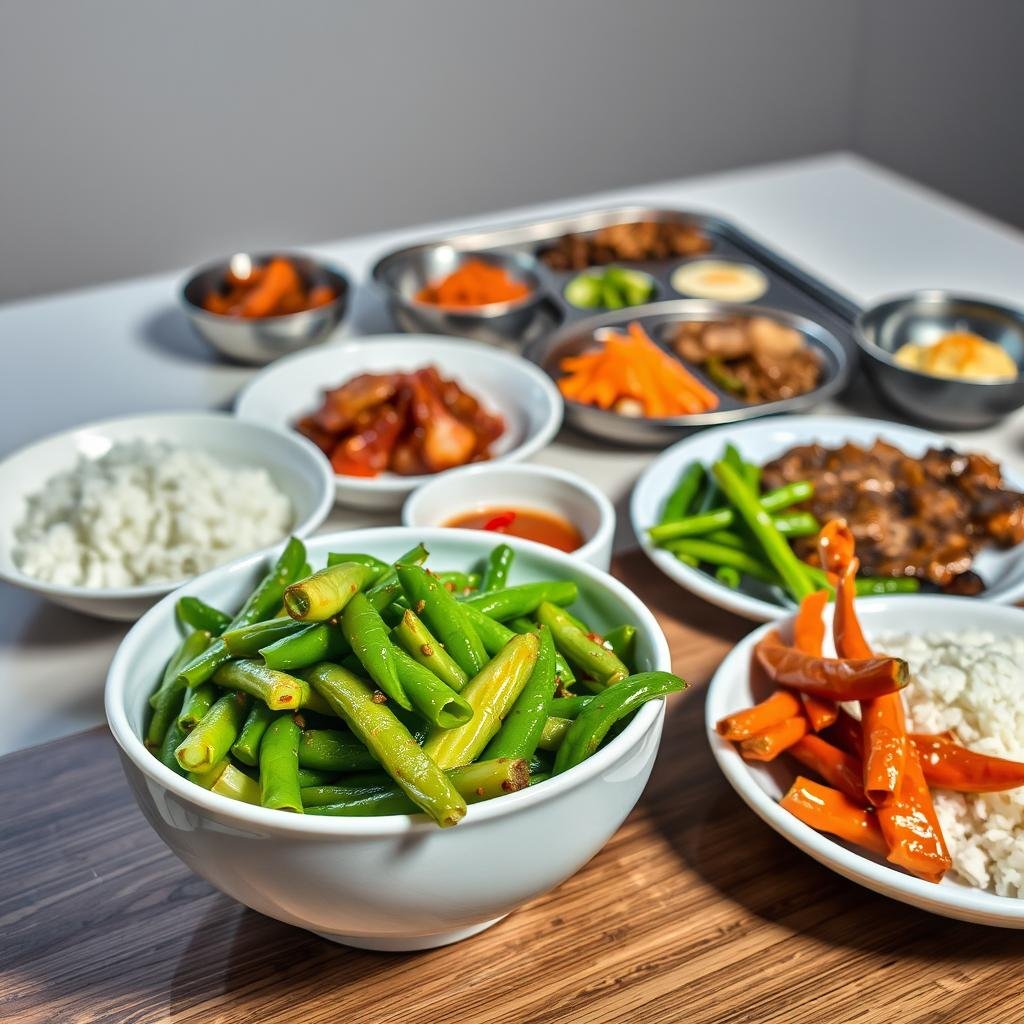
Green bean kimchi is a key part of Korean cuisine. It brings together the bright tastes of old recipes and Korea’s rich culture. Its tangy and spicy flavors add depth to many meals.
Popular Dishes Featuring Green Bean Kimchi
Green bean kimchi makes many dishes with kimchi even better. Here are some dishes that show its versatility:
- Kimchi Jjigae: A traditional stew with kimchi, pork, tofu, and veggies.
- Bibimbap: Mixed rice with green bean kimchi for a tangy kick.
- Kimchi Jeon: Savory pancakes with green bean kimchi for a crispy snack.
- Kimchi Fried Rice: Stir-fried rice with kimchi, veggies, and sometimes an egg.
Cultural Significance
Kimchi, including green bean kimchi, is very important in Korea. It’s more than a side dish; it’s a big part of Korean identity. It shows Korea’s love for food.
Making kimchi is a tradition passed down through generations. It shows the value of keeping cultural foods alive. This tradition brings people together, showing the importance of family and tradition in Korean cuisine.
Vegan and Gluten-Free Green Bean Kimchi Options
Green bean kimchi is great for many diets. To make vegan kimchi, just swap fish sauce for soy sauce or a plant-based umami liquid. This change makes it totally plant-based and tasty.
For those who can’t have gluten, use gluten-free soy sauce. This way, you can enjoy kimchi without gluten. It keeps all the flavors you love.
| Ingredient | Traditional Kimchi | Vegan Kimchi | Gluten-Free Kimchi |
|---|---|---|---|
| Fish Sauce | Yes | No | No |
| Soy Sauce | Optional | Yes | Yes (gluten-free variety) |
| Umami Flavor | Fish-based | Plant-based | Various gluten-free options |
This table shows how easy it is to make kimchi vegan and gluten-free. It keeps the real taste of kimchi. This opens up new options for people with different diets.
Common Mistakes to Avoid When Making Green Bean Kimchi

Making green bean kimchi can be tricky. Knowing common mistakes helps you avoid them. This way, you can make better-tasting kimchi and keep it safe to eat.
Incorrect Salt Ratios
One big mistake is using the wrong amount of salt. Salt is key in making kimchi. Too little salt can make the kimchi bad and spoil. Too much salt stops the fermentation and makes it taste bad.
Improper Storage Techniques
Storing kimchi right is very important. Bad storage can make the kimchi go bad, spoil, or get contaminated. Always use a tight container, like glass, and keep it in the fridge after it’s fermented. Keeping the right temperature is also key to stop bad bacteria and keep the good bacteria.
| Common Mistake | Impact |
|---|---|
| Incorrect Salt Ratios | Disrupts Fermentation, Spoils Texture, Alters Flavor |
| Improper Storage Techniques | Over-Fermentation, Spoilage, Contamination |
The Science Behind the Probiotic Properties of Green Bean Kimchi
The probiotic properties in green bean kimchi come from fermentation. This old method uses good bacteria to change the green beans. It’s called lacto-fermentation.
As green bean kimchi ferments, good bacteria break down sugars. This makes the environment acidic. It preserves the food and helps probiotics grow.
Probiotics are live good bacteria that help our health. They are important for a healthy gut. This is key for digestion and our immune system.
Studies show eating probiotics, like in green bean kimchi, helps our gut. It also helps our mind through the gut-brain axis.
Also, fermentation keeps green bean kimchi full of nutrients. Vitamins, minerals, and antioxidants become easier for our bodies to use. This makes kimchi a great food for health.
Knowing how kimchi is made helps us see its health benefits. It’s a traditional Korean food that’s full of good stuff.

